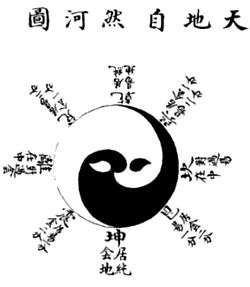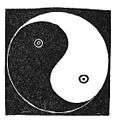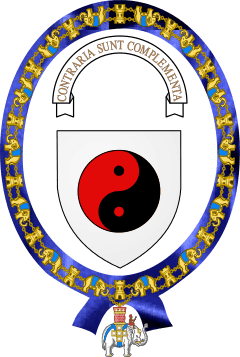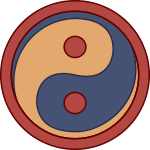Taijitu
A taijitu (simplified Chinese: 太极图; traditional Chinese: 太極圖; pinyin: tàijítú; Wade–Giles: t'ai⁴chi²t'u²) is a symbol or diagram (图 tú) in Chinese philosophy representing Taiji (太极 tàijí "great pole" or "supreme ultimate") in both its monist (wuji) and its dualist (yin and yang) aspects. Such a diagram was first introduced by Song Dynasty philosopher Zhou Dunyi (周敦頤 1017–1073) in his Taijitu shuo 太極圖說.


| Taijitu | |||||||||||||||||||||
|---|---|---|---|---|---|---|---|---|---|---|---|---|---|---|---|---|---|---|---|---|---|
| Chinese name | |||||||||||||||||||||
| Traditional Chinese | 太極圖 | ||||||||||||||||||||
| Simplified Chinese | 太极图 | ||||||||||||||||||||
| |||||||||||||||||||||
| Vietnamese name | |||||||||||||||||||||
| Vietnamese alphabet | Thái cực đồ | ||||||||||||||||||||
| Hán-Nôm | 太極圖 | ||||||||||||||||||||
| Korean name | |||||||||||||||||||||
| Hangul | 태극도 | ||||||||||||||||||||
| Hanja | 太極圖 | ||||||||||||||||||||
| |||||||||||||||||||||
| Japanese name | |||||||||||||||||||||
| Hiragana | たいきょくず | ||||||||||||||||||||
| Shinjitai | 太極図 | ||||||||||||||||||||
| |||||||||||||||||||||
The modern Taoist canon, compiled during the Ming era, has at least half a dozen variants of such taijitu. The two most similar are the "Taiji Primal Heaven" (太極先天圖 tàijí xiāntiān tú) and the "wuji" (無極圖 wújí tú) diagrams, both of which have been extensively studied during the Qing period for their possible connection with Zhou Dunyi's taijitu.[1]
Ming period author Lai Zhide (1525–1604) simplified the taijitu to a design of two interlocking spirals. In the Ming era, the combination of the two interlocking spirals of the taijitu with two black-and-white dots superimposed on them became identified with the He tu or "Yellow River diagram" (河圖). This version was reported in Western literature of the late 19th century as the "Great Monad",[2] and has been widely popularised in Western popular culture as the "yin-yang symbol" since the 1960s.[3] The contemporary Chinese term for the modern symbol is 太极兩儀图 "two-part Taiji diagram".
Ornamental patterns with visual similarity to the "yin-yang symbol" are found in archaeological artefacts of European prehistory; such designs are sometimes descriptively dubbed "yin yang symbols" in archaeological literature by modern scholars.[4][5][6]
Structure

The taijitu consists of five parts. Strictly speaking, the "yin and yang symbol", itself popularly called taijitu, represents the second of these five parts of the diagram.
- At the top, an empty circle depicts the absolute (Wuji)
- A second circle represents the Taiji as harboring Dualism, yin and yang, represented by filling the circle in a black-and-white pattern. In some diagrams, there is a smaller empty circle at the center of this, representing Emptiness as the foundation of duality.
- Below this second circle is a five-part diagram representing the Five Agents (Wuxing), representing a further stage in the differentiation of Unity into Multiplicity. The Five Agents are connected by lines indicating their proper sequence, Wood (木) → Fire (火) → Earth (土) → Metal (金) → Water (水).
- The circle below the Five Agents represents the conjunction of Heaven and Earth, which in turn gives rise to the "ten thousand things". This stage is also represented by the Eight Trigrams (Bagua).
- The final circle represents the state of multiplicity, glossed "The ten thousand things are born by transformation" (萬物化生; modern 化生万物)
History
The term taijitu in modern Chinese is commonly used to mean the simple "divided circle" form (![]()
Song era
While the concept of yin and yang dates to Chinese antiquity,[7] the interest in "diagrams" (圖 tú) is an intellectual fashion of Neo-Confucianism during the Song period (11th century), and it declined again in the Ming period, by the 16th century.[8]
The original description of a taijitu is due to Song era philosopher Zhou Dunyi (1017–1073), author of the Taijitu shuo 太極圖說 "Explanation of the Diagram of the Supreme Ultimate", which became the cornerstone of Neo-Confucianist cosmology. His brief text synthesized aspects of Chinese Buddhism and Taoism with metaphysical discussions in the Yijing.
Zhou's key terms Wuji and Taiji appear in the opening line 無極而太極, which Adler notes could also be translated "The Supreme Polarity that is Non-Polar".
Non-polar (wuji) and yet Supreme Polarity (taiji)! The Supreme Polarity in activity generates yang; yet at the limit of activity it is still. In stillness it generates yin; yet at the limit of stillness it is also active. Activity and stillness alternate; each is the basis of the other. In distinguishing yin and yang, the Two Modes are thereby established. The alternation and combination of yang and yin generate water, fire, wood, metal, and earth. With these five [phases of] qi harmoniously arranged, the Four Seasons proceed through them. The Five Phases are simply yin and yang; yin and yang are simply the Supreme Polarity; the Supreme Polarity is fundamentally Non-polar. [Yet] in the generation of the Five Phases, each one has its nature.[9]
Instead of usual Taiji translations "Supreme Ultimate" or "Supreme Pole", Adler uses "Supreme Polarity" (see Robinet 1990) because Zhu Xi describes it as the alternating principle of yin and yang, and ...
insists that taiji is not a thing (hence "Supreme Pole" will not do). Thus, for both Zhou and Zhu, taiji is the yin-yang principle of bipolarity, which is the most fundamental ordering principle, the cosmic "first principle." Wuji as "non-polar" follows from this.
Since the 12th century, there has been a vigorous discussion in Chinese philosophy regarding the ultimate origin of Zhou Dunyi's diagram. Zhu Xi (12th century) insists that Zhou Dunyi had composed the diagram himself, against the prevailing view that he had received it from Daoist sources. Zhu Xi could not accept a Daoist origin of the design, because it would have undermined the claim of uniqueness attached to the Neo-Confucian concept of dao.[8]
Ming era

While Zhou Dunyi (1017–1073) popularized the circular diagram,[12] the introduction of "swirling" patterns first appears in the Ming period.
Zhao Huiqian (趙撝謙, 1351–1395) was the first to introduce the "swirling" variant of the taijitu in his Liushu benyi (六書本義, 1370s). The diagram is combined with the eight trigrams (bagua) and called the "River Chart spontaneously generated by Heaven and Earth". By the end of the Ming period, this diagram had become a widespread representation of Chinese cosmology.[13] The dots were introduced in the later Ming period (replacing the droplet-shapes used earlier, in the 16th century) and are encountered more frequently in the Qing period.[14] The dots represent the seed of yin within yang and the seed of yang within yin; the idea that neither can exist without the other.
Lai Zhide's design is similar to the gakyil (dga' 'khyil or "wheel of joy") symbols of Tibetan Buddhism; but while the Tibetan designs have three or four swirls (representing the Three Jewels or the Four Noble Truths, i.e. as a triskele and a tetraskelion design), Lai Zhide's taijitu has two swirls, terminating in a central circle.[15]
Modern yin-yang symbol
The Ming-era design of the taijitu of two interlocking spirals has been reported as "yin-yang symbol" in the first half of the 20th century. The flag of South Korea, originally introduced as the flag of Joseon era Korea in 1882, shows this symbol in red and blue. This was a modernisation of the older (early 19th century) form of the Bat Quai Do used as the Joseon royal standard.
Since the 1960s, "yin-yang symbol" is most widely applied to the He tu symbol which combines the two interlocking spirals with two dots. In the standard form of the contemporary "yin-yang symbol", one draws on the diameter of a circle two non-overlapping circles each of which has a diameter equal to the radius of the outer circle. One keeps the line that forms an "S", and one erases or obscures the other line.[16] The design is also described "pair of fishes nestling head to tail against each other".[17]
The Soyombo symbol of Mongolia may be prior to 1686. It combines several abstract shapes, including a Taiji symbol illustrating the mutual complement of man and woman. In socialist times, it was alternatively interpreted as two fish symbolizing vigilance, because fish never close their eyes.[18]
The modern symbol has also been widely used in martial arts, particularly t'ai chi ch'uan (Taijiquan),[19] and Jeet Kune Do, since the 1970s.[20] In this context, it is generally used to represent the interplay between hard and soft techniques.
The dots in the modern "yin-yang symbol" have been given the additional interpretation of "intense interaction" between the complementary principles. [21]
.svg.png) The 1882 flag of Korea (since 1949 the flag of South Korea)
The 1882 flag of Korea (since 1949 the flag of South Korea) "The Great Monad" from Edna Kenton's Book of Earths (1928), after the design shown by Hampden Coit DuBose (1887)
"The Great Monad" from Edna Kenton's Book of Earths (1928), after the design shown by Hampden Coit DuBose (1887)_(14595808127).jpg) The "cycle of Cathay" as depicted by William Alexander Parsons Martin in 1897.[22]
The "cycle of Cathay" as depicted by William Alexander Parsons Martin in 1897.[22] Coat of arms adopted by Niels Bohr in 1947, showing a taijitu in red and black, with the motto contraria sunt complementa ("opposites are complementary").[23]
Coat of arms adopted by Niels Bohr in 1947, showing a taijitu in red and black, with the motto contraria sunt complementa ("opposites are complementary").[23] "Yin-Yang symbol or Tao symbol" (without the dots) as reported in 1964.[24]
"Yin-Yang symbol or Tao symbol" (without the dots) as reported in 1964.[24]
.png) Several flags of Mongolia have incorporated a taiji symbol since 1911.
Several flags of Mongolia have incorporated a taiji symbol since 1911. The flag of Tibet has included a taijitu since 1916
The flag of Tibet has included a taijitu since 1916.svg.png) Roundel of the Republic of Singapore Air Force included a taijitu between 1973 and 1990.
Roundel of the Republic of Singapore Air Force included a taijitu between 1973 and 1990.
Similar symbols
Similarities can be seen in Neolithic–Eneolithic era Cucuteni–Trypillia culture on the territory of current Ukraine and Romania. Patterns containing ornament looking like Taijitu from archeological artifacts of that culture were displayed in the Ukraine pavilion at the Expo 2010 in Shanghai, China.[25]

The interlocking design is found in artifacts of the European Iron Age.[4][26]
While this design appears to become a standard ornamental motif in Iron-Age Celtic culture by the 3rd century BC, found on a wide variety of artifacts, it is not clear what symbolic value was attached to it.[27][28] Unlike the Chinese symbol, the Celtic yin-yang lack the element of mutual penetration, and the two halves are not always portrayed in different colors.[29] Comparable designs are also found in Etruscan art.[5]
In computing
Unicode features the "yin-yang symbol" in the Miscellaneous Symbols block, at code point U+262F (YIN YANG ☯). The related "double body symbol" is included at U+0FCA (TIBETAN SYMBOL NOR BU NYIS -KHYIL ࿊), in the Tibetan block. The Soyombo symbol, that includes a taijitu, is available in Unicode as U+11A9E, 𑪞, U+11A9F, 𑪟, and U+11AA0, 𑪠.
See also
- Gankyil
- Taegukgi
- Taegeuk
- Three hares
- Tomoe
- Triskelion
- Koru
- Tarim mummies
- Lauburu
References
- Joseph A. Adler, Reconstructing the Confucian Dao: Zhu Xi's Appropriation of Zhou Dunyi, SUNY Press, 2014, p. 153
- Labelled "The Great Monad" by Hampden Coit DuBose, The Dragon, Image, and Demon: Or, The Three Religions of China; Confucianism, Buddhism, and Taoism (1887), p. 357
- "The 'River Diagram' is the pattern of black-and-white dots which appears superimposed on the interlocking spirals [...] Those spirals alone form the Taiji tu or 'Diagram of the Supreme Ultimate', often known in English since the 1960s as the 'yin-yang symbol'.) These dots were believed to be collated with the eight trigrams, and hence with the concepts of roundness and of the heavens, while the equally numinous 'Luo River Writing' was a pattern of dots accosiated with the number nine, with squareness and with the earth." Craig Clunas, Pictures and Visuality in Early Modern China (1997), p. 107.
- Peyre 1982, pp. 62–64, 82 (pl. VI); Harding 2007, pp. 68f., 70f., 76, 79, 84, 121, 155, 232, 239, 241f., 248, 253, 259; Duval 1978, p. 282; Kilbride-Jones 1980, pp. 127 (fig. 34.1), 128; Laing 1979, p. 79; Verger 1996, p. 664; Laing 1997, p. 8; Mountain 1997, p. 1282; Leeds 2002, p. 38; Megaw 2005, p. 13
- Peyre 1982, pp. 62–64
- Monastra 2000; Nickel 1991, p. 146, fn. 5; White & Van Deusen 1995, pp. 12, 32; Robinet 2008, p. 934
- in the I Ching, originally a divination manual of the Western Zhou period (c. 1000–750 BC), yin and yang are represented by broken and solid lines: yin is broken (⚋) and yang is solid (⚊).
- Joseph A. Adler, Reconstructing the Confucian Dao: Zhu Xi's Appropriation of Zhou Dunyi, SUNY Press, 2014, p. 152
- Adler, Joseph A. (1999). "Zhou Dunyi: The Metaphysics and Practice of Sagehood", in Sources of Chinese Tradition, William Theodore De Bary and Irene Bloom, eds. 2nd ed., 2 vols. Columbia University Press. pp. 673–674.
- Louis (2003), p. 171. The facing page shows an earlier copy, dated 1520, with an essentially identical diagram.
- Louis (2003:294) shows a version of Lai Zhide's diagram in a 1969 representation. The origin of the image shown here, omitting the "River Diagram" superimposed on the spirals, is unknown (uploaded in 2006)
- Xinzhong Yao (13 February 2000). An introduction to Confucianism. Cambridge University Press. pp. 98–. ISBN 978-0-521-64430-3. Retrieved 29 October 2011.
- François Louis, 'The Genesis of an Icon: The "Taiji" Diagram's Early History', Harvard Journal of Asiatic Studies 63.11 (June 2003), 145–196.
- Louis (2003) has diagrams with dots dated to 1623 (p. 187) and 1688 (p. 146, p. 190).
- Robert Beer, The Handbook of Tibetan Buddhist Symbols, 2003, p. 209
- Peyre 1982, pp. 62f.
- Robinet 2008, p. 934
- Pu̇revsambuu, G. (2006). Mongolia. Ulaanbaatar, Mongolia: Montsame. p. 8. ISBN 99929-0-627-8.
- Davis, Barbara (2004). Taijiquan Classics. Berkeley, California: North Atlantic Books. p. 212. ISBN 978-1-55643-431-0.
- "Yin Yang symbol" (with dots) as part of "embroidered emblems", Martial Arts Shopping Guide (advertisement), Black Belt magazine, August 1974, p. 23.
- "the yin/yang symbol so familiar to us contains a white dot amid the black and a black dot amid the white to indicate that these principles interact intensely." Norman R. Kraft, Ogdoadic Magick, Weiser Books, 1969, p. 23.
- "The figures in the inner space are the dual forces, Yin and Yang, symbolized by darkness and light, which forms the starting point of Chinese philosophy" W.A.P. Martin, A cycle of Cathay, or, China, south and north (1897).
- Numericana - Escutcheons of Science
- Archie J. Bahm, The World's Living Religions, Jain Publishing Company, 1964, p. 156.
- More about Taiji Symbols of Ukraine Pavilion at Expo 2010 (xingyimax.com)
- Peyre 1982, pp. 62–64, 82 (pl. VI)
- beaked flagons, helmets, vases, bowls, collars, hand-pins, cross-slabs, brooches and knife blades. Harding 2007, pp. 70f., 76, 79, 155, 232, 241f., 248, 259; Kilbride-Jones 1980, p. 128
- "apotropaic": Duval 1978, p. 282
- Duval 1978, p. 282; Monastra 2000
Sources
- Duval, Paul-Marie (1978), Die Kelten, München: C. H. Beck, ISBN 3-406-03025-4
- Harding, D. W. (2007), The Archaeology of Celtic Art, Routledge, ISBN 0-203-69853-3
- Kilbride-Jones, H. E. (1980), Celtic Craftsmanship in Bronze, Taylor & Francis, ISBN 0-7099-0387-1
- Laing, Lloyd (1979), Celtic Britain, Routledge & Kegan Paul Ltd, ISBN 0-7100-0131-2
- Laing, Lloyd (1997), Later Celtic Art in Britain and Ireland, Shire Publications LTD, ISBN 0-85263-874-4
- Megaw, Ruth and Vicent (2005), Early Celtic Art in Britain and Ireland, Shire Publications LTD, ISBN 0-7478-0613-6
- Monastra, Giovanni (2000), "The "Yin-Yang" among the Insignia of the Roman Empire?", Sophia, 6 (2), archived from the original on 2011-09-25
- Mountain, Harry (1997), The Celtic Encyclopedia, 5, ISBN 1-58112-894-0
- Nickel, Helmut (1991), "The Dragon and the Pearl", Metropolitan Museum Journal, 26: 139–146, doi:10.2307/1512907
- Peyre, Christian (1982), "Y a-t'il un contexte italique au style de Waldalgesheim?", in Duval, Paul-Marie; Kruta, Venceslas (eds.), L’art celtique de la période d’expansion, IVe et IIIe siècles avant notre ère, Hautes études du monde gréco-romain, 13, Paris: Librairie Droz, pp. 51–82 (62–64, 82), ISBN 978-2-600-03342-8
- Robinet, Isabelle (2008), "Taiji tu. Diagram of the Great Ultimate", in Pregadio, Fabrizio (ed.), The Encyclopedia of Taoism A−Z, Abingdon: Routledge, pp. 934–936, ISBN 978-0-7007-1200-7
- Verger, Stéphane (1996), "Une tombe à char oubliée dans l'ancienne collection Poinchy de Richebourg", Mélanges de l'École française de Rome, 108 (2), pp. 641–691
- White, Lynn; Van Deusen, Nancy Elizabeth (1995), The Medieval West Meets the Rest of the World, Claremont Cultural Studies, 62, Institute of Mediaeval Music, ISBN 0-931902-94-0
External links
| Wikimedia Commons has media related to: |
